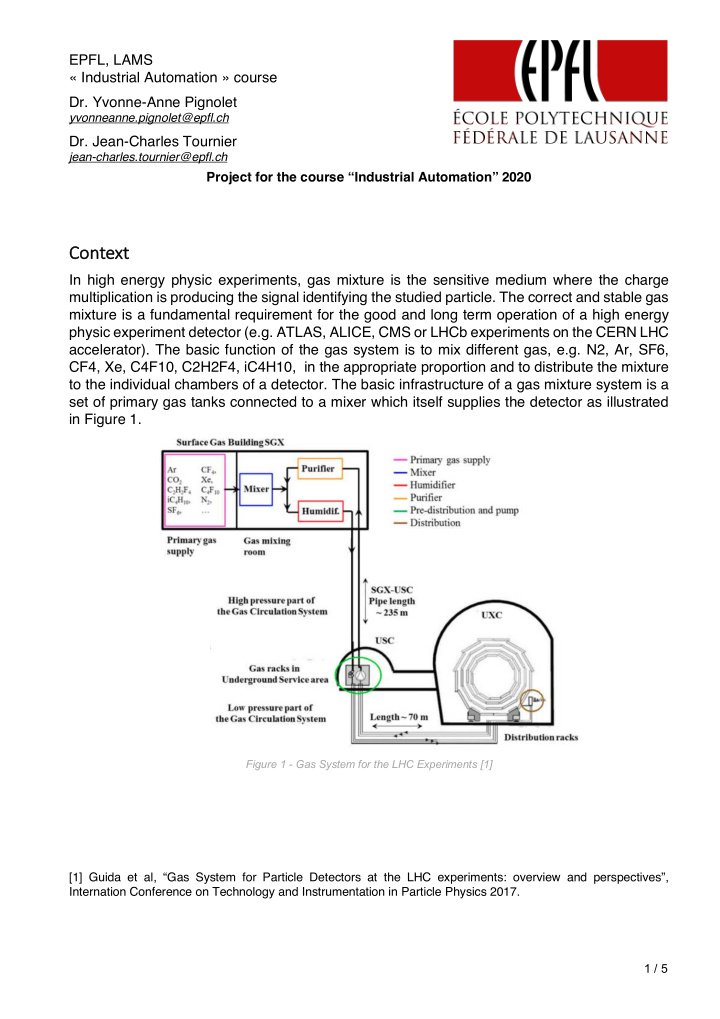



EPFL, LAMS « Industrial Automation » course Dr. Yvonne-Anne Pignolet yvonneanne.pignolet@epfl.ch Dr. Jean-Charles Tournier jean-charles.tournier@epfl.ch Project for the course “Industrial Automation” 2020 Co Context In high energy physic experiments, gas mixture is the sensitive medium where the charge multiplication is producing the signal identifying the studied particle. The correct and stable gas mixture is a fundamental requirement for the good and long term operation of a high energy physic experiment detector (e.g. ATLAS, ALICE, CMS or LHCb experiments on the CERN LHC accelerator). The basic function of the gas system is to mix different gas, e.g. N2, Ar, SF6, CF4, Xe, C4F10, C2H2F4, iC4H10, in the appropriate proportion and to distribute the mixture to the individual chambers of a detector. The basic infrastructure of a gas mixture system is a set of primary gas tanks connected to a mixer which itself supplies the detector as illustrated in Figure 1. Figure 1 - Gas System for the LHC Experiments [1] [1] Guida et al, “Gas System for Particle Detectors at the LHC experiments: overview and perspectives”, Internation Conference on Technology and Instrumentation in Particle Physics 2017. 1 / 5
For the purpose of the Industrial Automation project, the mixer installation illustrated in Figure 2 is considered. The installation is made of two primary gas tanks. In addition to the two primary fixed gas tanks, a mobile recovery unit can be connected to either replace one of the two primary fixed gas tank or to deliver the already mixed gas. The mobile recovery unit is used when one, or both, primary tank is not available (instrumentation issue or empty tank). Note that in the context of the project, the equipment after the valve MV-700 is no considered. Figure 2 - Process and Instrumentation Diagram (P&ID) of the studied installation 2 / 5
Ta Tasks Considering the system presented in Figure 2, you will have to perform the following tasks: 1. Automation Architecture Define the automation architecture of the gas mixer installation including the mobile unit: § I/O cards to connect to all sensors and actuators § PLC or industrial controllers (type, number, etc.) § Network infrastructure (cables, wireless, routers, access points, protocols, etc.) § SCADA server(s), c.f. tasks 2.c All choices will have to be motivated and as precise as possible with reference and links to the different manufacturers catalog. 2. Supervision Using Tango, design the supervision system required to monitor and control the installation. 2.1. Identify which information is relevant for the supervision § List of signals to monitor § List of signals to control 2.2. Define which information should be defined as an alarm based on the criteria presenting in the course 2.3. Define the Tango architecture including the following points 2.3.1. Logical architecture ¨ Data flow ¨ Number of device servers ¨ Device server software architecture 2.3.2. Mapping to the physical architecture defined in 1. 2.4. Develop a device server for the primary fixed gas tank 2.5. Develop the synoptic view(s) required for the supervision of the installation. The synoptic views should be designed according to the principles presented in class regarding the development of industrial HMIs. The synoptic views should be first designed as wireframe. The synoptic views related to the primary gas tanks should 3 / 5
then be implemented in Tango and animated by the device server implemented in the previous step. 3. Manufacturing Execution System 3.1. What is the specific purpose of resource allocation and performance analysis modules of a MES in the context of this project 3.2. Describe a concrete performance measurement which is of interest to the operators 3.3. What is needed on the neighboring layers of the automation pyramid to facilitate this measurement. 4. Qualitive Dependability Analysis Perform a qualitative dependability evaluation (FMEA and/or FTA, motivate your choice) of the overall system. You will first have to clearly identify the different components considered for the analysis before performing the analysis itself. 4 / 5
The project shall be executed by an interdisciplinary team. Given the amount of work to be done to complete the project, the team will have to organize itself to split the work among the different members. During the second part of the semester, time will be dedicated during the classes for the team to work on the project and interact directly with the instructors to refine the requirements and make the necessary assumptions. Outside classes, the expected load for each team member is around 20 hours. Please refer to the document “Project Timeline and Evaluation” to identify the different project milestones and evaluation criteria for the project. Schedule Suggestions Until 10.03.2020: Agree on work assignment within the team Until 17.03.2020: Discuss criteria and constraints Until 31.03.2020 Draft for report on task 1, and 2.1&2 Draft for 2.3 and 2.4 Until 07.04.2020 Implement very basic version for 2.4 and 2.5 Draft for 3 Until 07.04.2020 Discuss work assignment, adjust if necessary Implement more complete version for 2.4 and 2.5 Revise report (see evaluation criteria), outline slides for tasks 1-3. Until 21.04.2020 Test and improve implementation for 2.4 and 2.5 Describe implementation in report Polish report 28.04.2020 Hand in intermediate report Until 05.05.2020 Reflect on work done so far Draft for report on task 4 Until 12.05.2020 Revise report (see evaluation criteria) Outline slides Until 19.05.2020 Polish report Create slides 20.05.2020 Hand in final report Until 26.05.2020 Polish slides, Practice presentation, Evaluate other teams 26.05.2020 Hand in evaluation & Project Presentation 5 / 5
Recommend
More recommend